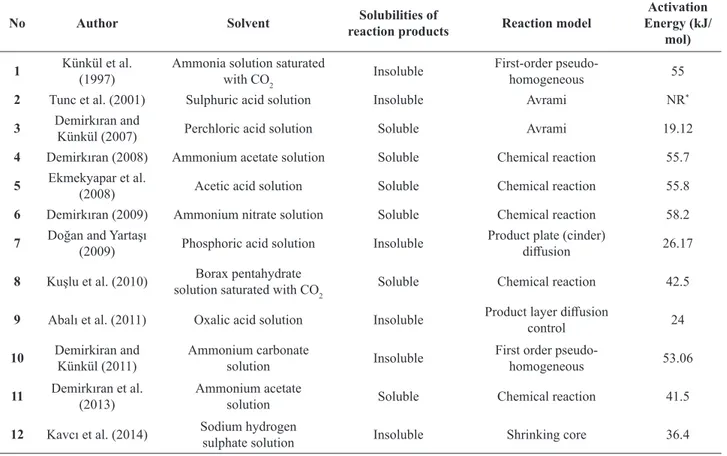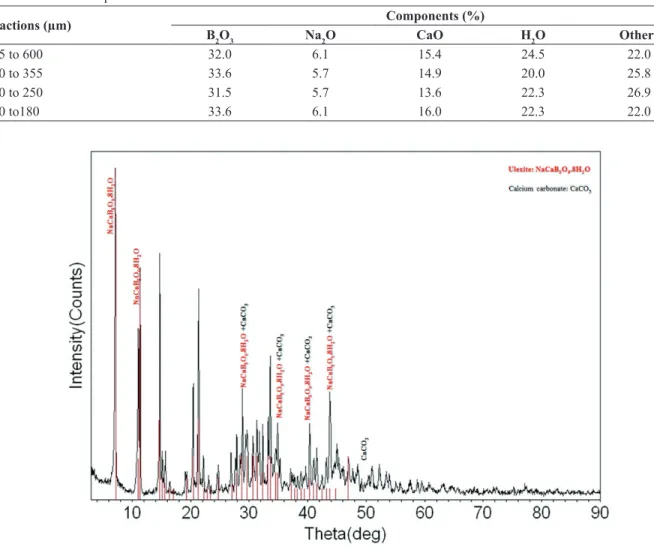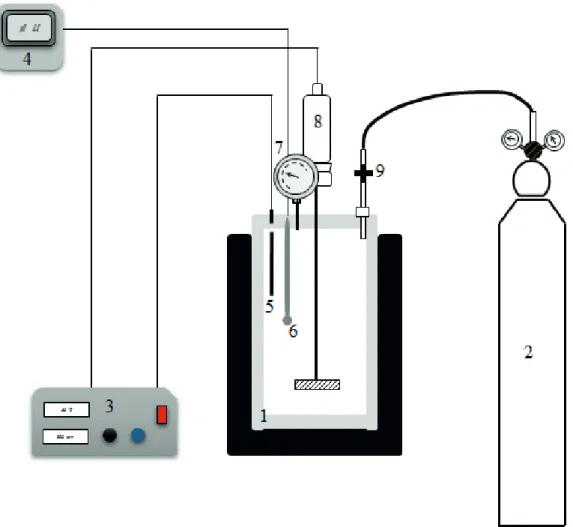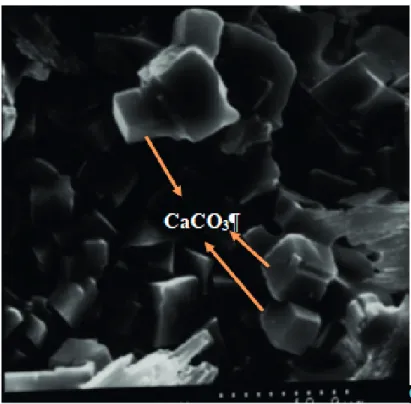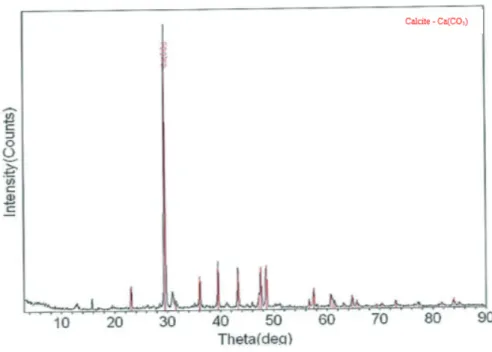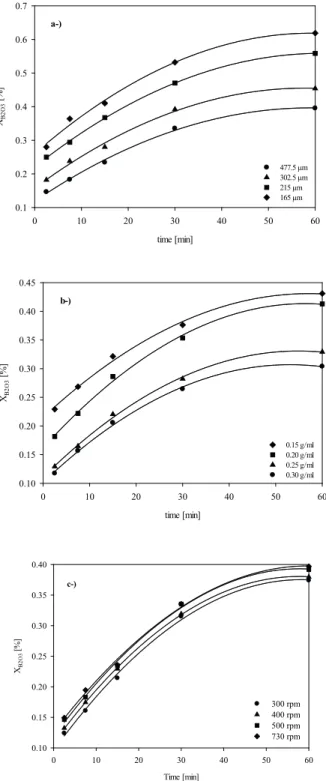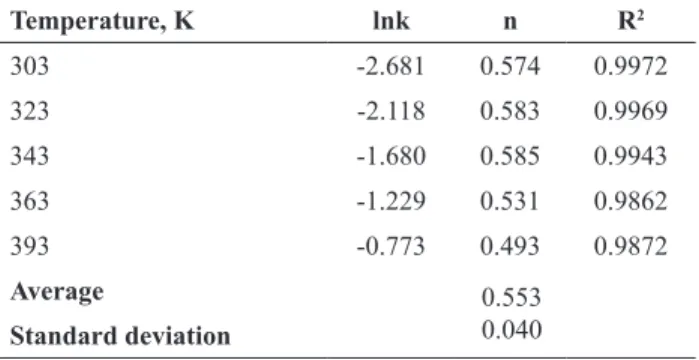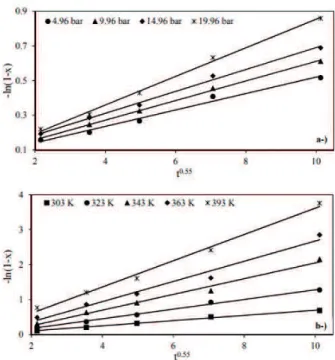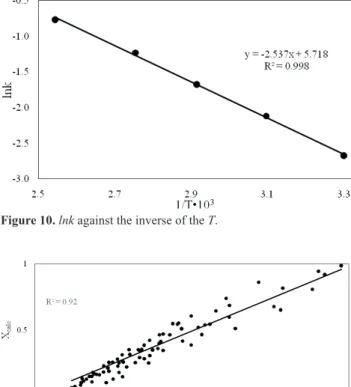Brazilian Journal
of Chemical
Engineering
ISSN 0104-6632 Printed in Brazil www.scielo.br/bjce
Vol. 35, No. 01, pp. 111 – 122, January – March, 2018
* Corresponding Author: Hüseyin Elçiçek. E-mail: helcicek@gmail.com dx.doi.org/10.1590/0104-6632.20180351s20160084
LEACHING KINETICS OF ULEXITE ORE IN
AQUEOUS MEDIUM AT DIFFERENT CO
2
PARTIAL
PRESSURES
Hüseyin Elçiçek
1,*and Mehmet M. Kocakerim
21 Department of Naval Architect and Marine Engineering, Faculty of Naval Arch. & Maritime, Yildiz Technical University, Istanbul, Turkey
2 Department of Chemical Engineering, Faculty of Engineering, Çankırı Karatekin University, Çankırı, Turkey E-mail: mkocakerim@yahoo.com.tr
(Submitted: November 8, 2015; Revised: August 22, 2016; Accepted: September 30, 2016)
Abstract – This manuscript presents a study regarding the leaching kinetics of ulexite (Na2O.2CaO.5B2O3.16H2O)
under different CO2 partial pressures in aqueous media. The effects of the reaction temperature, particle size, CO2 partial pressure, solid-liquid ratio, and agitation speed were investigated in the boron extraction from the ore. As a result of the experimental studies, it was found that the leaching rate increased with the rise in the reaction temperature and CO2 partial pressure, and decreased with the increase in the particle size and solid-liquid ratio. The reaction temperature was
found to be a significant parameter affecting the leaching rate, which varied from 13% to 97% between 303 and 393 K. Agitation speed appears to have no significant effect on the leaching rate. By using several empirical kinetic models to correlate the experimental data, it was found that the leaching rate fits to the Avrami Model. The activation energy of
the process is found to be 21.1 kJ.mol-1.
Keywords: Ulexite, leaching kinetics, CO2 partial pressure, Avrami Model
INTRODUCTION
Throughout decades, possessing natural resources has been a critical driving force for global economic development. Among the other countries, Turkey possesses
72% of the world’s reserves of boron minerals, and this
gives her a superior advantage in boron mineral products
(Ertuğrul, 2004; Kuşlu et al., 2010). Boron minerals are
mainly compounds which consist of boron oxide with alkaline and/or alkaline earth metal oxides, and they exist in more than 230 forms in nature. Boron and its compounds are potentially valuable products for industry and have
strategic importance (Elcicek et al., 2014; Guliyev et al.,
2012). It is the most widely used element in engineering applications and in industry, such as nuclear engineering,
manufacturing of high-quality steel, ceramics, textiles; in the production of heat resistant polymers, cosmetics; processing of leather, rubber, paint; and in agriculture, or
used as catalyst (Guliyev et al., 2012).
Since 1963, a number of studies have been published on the dissolution of boron minerals in various solutions, such
as hydrochloric acid (Imamutdinova, 1963; Zdonovskii and
Imamutdinova, 1963), phosphoric acid (Imamutdinova,
1967), perchloric acid (Imamutdinova and Vladykina,
1969), acetic acid (Imamutdinova and Abdrashitova,
1970) and oxalic acid (Kalacheva et al., 1980). The
extraction of boric acid was investigated from colemanite ore (2CaO.3B2O3.5H2O) by supercritical carbon dioxide.
colemanite reaction at 60°C, for 2h of reaction time (Budak and Gönen, 2014). The extraction of boric acid was examined from tincal (Na2O.2B2O3.10H2O) mineral by
supercritical ethanol. The maximum extraction efficiency of boric acid was 32.6%, at 250°C (Levent et al., 2016). One of the most important parameters affecting the dissolution
kinetics of boron minerals is the choice of the solvent. Therefore, the results from this study have been compared with the results from previous studies in the literature in terms of solvents used, solubility of reaction products in water, and in terms of the obtained results, the reaction model and the activation energy in Table 1. The authors have not explained how their results are related to models. It is expected that the presence of strong acids increases the dissolution rate of ulexite. However, at the beginning of the reaction, H3O+ ions are furnished by the acid and boric acid is produced in a very fast reaction. So, a firm layer in which there are fine-grained boric acid crystals is
produced around the ulexite particles. This layer resists the passsage of H3O+ ions to the mineral surface, and affects
the dissolution rate negatively. The dissolution kinetics of the ulexite under atmospheric conditions in carbonic acid
solution was found to fit a first-order pseudo-homogeneous
reaction model. The studies of the dissolution kinetics of ulexite in ammonia/CO2 and ammonium carbonate solution
were described by a first-order pseudo-homogeneous
reaction model. In these systems, CaCO3 crystals forming
in the reactions do not form a firm film layer, and peel off.
In all the studies mentioned above, the experiments were conducted at low temperatures and low solid/liquid ratios under atmospheric pressure. The use of water, compared with other solvents in the industrial applications, provides economically feasible and safe operations. We believed that other solvents are only used during the laboratory tests to enhance solubility.
The study presented is about the leaching kinetics of ulexite ore in aqueous media under various CO2 partial pressures. The results show that the leaching rate of ulexite increased with the increase in the pressure of CO2 according to the studies conducted under atmospheric conditions (the other conditions are kept stable). Therefore, application of overpressures of CO2 is more favoured. However, optimization study is required to make a decision (Elçiçek, 2012). The study conducted by Ata et al. (2000) was about optimization of boric acid extraction from colemanite in CO2-saturated water. Colemanite dissolution in CO2-saturated water is slower than that of ulexite. The dissolution kinetics of inderite [MgB3O3(OH)5•5(H2O)] and inyoite [Ca2B6O6(OH)10•8(H2O)], which have no economic value, has less importance in CO2 saturated water. Ulexite
ore used in the present study contains nearly 75% ulexite,
and is processed industrially (Alkan et al., 1991).
Table 1. Previous studies about leaching kinetics of ulexite.
No Author Solvent Solubilities of
reaction products Reaction model
Activation Energy (kJ/
mol) 1 Künkül et al.
(1997) Ammonia solution saturated with CO2 Insoluble
First-order
pseudo-homogeneous 55
2 Tunc et al. (2001) Sulphuric acid solution Insoluble Avrami NR*
3 Demirkıran and Künkül (2007) Perchloric acid solution Soluble Avrami 19.12
4 Demirkıran (2008) Ammonium acetate solution Soluble Chemical reaction 55.7
5 Ekmekyapar et al.
(2008) Acetic acid solution Soluble Chemical reaction 55.8
6 Demirkıran (2009) Ammonium nitrate solution Soluble Chemical reaction 58.2
7 Doğan and Yartaşı
(2009) Phosphoric acid solution Insoluble
Product plate (cinder)
diffusion 26.17
8 Kuşlu et al. (2010) Borax pentahydrate
solution saturated with CO2 Soluble Chemical reaction 42.5
9 Abalı et al. (2011) Oxalic acid solution Insoluble Product layer diffusion
control 24
10 Demirkiran and Künkül (2011)
Ammonium carbonate
solution Insoluble
First order
pseudo-homogeneous 53.06
11 Demirkıran et al. (2013)
Ammonium acetate
solution Soluble Chemical reaction 41.5
12 Kavcı et al. (2014) Sodium hydrogen
sulphate solution Insoluble Shrinking core 36.4
Leaching kinetics of ulexite ore in aqueous medium at different CO2 partial pressures 113
Table 2. Chemical composition of ulexite fractions.
Fractions (µm) Components (%)
B2O3 Na2O CaO H2O Others
355 to 600 32.0 6.1 15.4 24.5 22.0
250 to 355 33.6 5.7 14.9 20.0 25.8
180 to 250 31.5 5.7 13.6 22.3 26.9
150 to180 33.6 6.1 16.0 22.3 22.0
Dissolution of ulexite in water-saturated carbon dioxide was investigated by Kocakerim et al. (1993). In their study,
the pure ulexite mineral was used; maximum temperature
was 303 K, and all the experiments were carried out under atmospheric conditions. Activation energy in their study
was found to be 51.7 kJ.mol-1, which fits with first order
kinetics.
Unlike the previous research mentioned above, this study aims to determine the leaching kinetics of ulexite in
water at different CO2 partial pressures. For this purpose, the effects of CO2 partial pressure, reaction temperature,
particle size, the solid-liquid ratio and the agitation speed on the leaching kinetics were investigated.
MATERIALS AND METHODS
Ulexite ore used in this study was obtained from Eti Mine Bigadic Boron Works. The sample was crushed by a jaw crusher and sieved using ASTM standard sieves to obtain the following size fractions: 355 to 600, 250 to
355, 180 to 250, and 150 to180 μm. The chemical analysis
of the fractions is given in Table 2. Gaseous CO2 used
in experiments was in a cylinder supplied from HABAŞ Corp. and was 99.5% pure. X-ray diffraction analysis of
ulexite ore is shown in Fig. 1.
Experimental procedure
Experiments were conducted in a 1000 mL reactor (Model 4540, Parr Instrument Company) which provided the temperature, pressure, agitation speed and pH control. In each experiment, 200 mL of distilled water and suitable amounts of ulexite were loaded into the reactor according to the present solid-liquid ratios.The reactor was adjusted to the desired operating conditions, and it was heated to the desired temperature with an external heating jacket. Experiments were started after the CO2 was pumped into the reactor to the desired pressure. The temperature and the pressure inside the reactor were monitored by the thermocouple and the pressure gauge. The samples were
withdrawn from the reactor after 2.5, 7.5, 15, and 30 and
Table 3. The reaction parameters chosen and their ranges.
Parameters Values
Total pressure, bar 5*, 10, 15, 20
Temperature, K 303*, 323, 343, 363, 393
Particle size µm 150 to 180, 180 to 250, 250 to 355, 355 to 600*
Solid-liquid ratio, g/mL 30/200, 40/200*, 50/200, 60/200
Stirring speed, rpm 300, 400, 500*, 730
*The values were kept constant when the effect of other parameters was investigated
60 minutes of leaching. The schematic representation of the system used in the experiments is seen in Fig. 2. The chosen parameters and their ranges are presented in Table 3.
At the end of each experiment, the solutions were
filtered using a blue band Whatman filter paper, and then
the liquid phase was analysed for B2O3 by a volumetric method. Also, Na+ and Ca2+ analyses were performed by a flame photometer with an uncertainty of ±1%. The
flame photometer was calibrated before each analysis.
The data obtained from each experiment were repeated two or three times, and the maximum standard deviation
was approximately 5%. The accuracy values of the thermocouple and pressure gauge are ± 1 °C and 0.1%,
respectively. The solution was stirred for the reaction
duration with 0.1% rpm sensitivity. The errors in the
parameters were measured. Total uncertainties are given in Table 4.
Leaching kinetics of ulexite ore in aqueous medium at different CO2 partial pressures 115
Table 4. The errors in parameters and total uncertainties.
Parameters Systematic errors
Temperatures ± 1°C
Pressure 0.1% bar
Agitation speed 0.1% rpm
Time ±0.5%
Na+ ±1 ppm
Ca2+ ±1 ppm
B2O3 ±0.01% mL
Calculated results Uncertainty
Leaching efficiency of B2O3 that passed from the ulexite ore into the solution was calculated by using the following Eq. 1:
(
)
(
)
2 3
sin in
0 t
10
total amount of ulexite pas g othe solution total amount of ulexiteinth
Leaching efficiency of
e original sample
B O = × (1)
The amount of CO2 captured was calculated from the change in CO2 gas concentration according to the stoichiometry of the reaction. The calculation was carried out as follows:
(2)
( )
( )( ) ( )( )( )( )( )( )
3
2 4
2 2
2
1
100
.
. 00 10
g
percent of ulexite in ore amount of sample
mole percent of B O leached
stoichiometric constant molecular wt of CO molecular wt of ulexi
CO
te
β η χ α
δ
×
= =
RESULTS AND DISCUSSION
Dissolution Reactions
The important reactions occurring in the system are written below:
( )
-+ 2+
-2 2 3 2 ( )s (aq) (aq) 5 6 4 a(q) (aq) 2 (aq)
Na O.2CaO.5B O .16H O
→
2Na
+2Ca
+2B O
OH
+4OH
+10H O
2 gas( ) 2(aq)
CO
CO
) 2 aq( ) 2 (a )q 2 3(aq
CO
+ H O
H CO
( ) +
-2 3 aq 2 (aq) 3 (aq) 3 aq( )
H CO
+ H O
H O
+ HCO
- 2- +
3 aq( ) 2 (aq) 3 aq( ) 3 (aq)
HCO
+ H O
CO
+ H O
( ) ( ) ( )
+
-3 aq aq 2 aq
H O
+ OH
2H O
( ) ( ) ( )
2+
2-aq 3 aq 3 s
2Ca
+ 2CO
2CaCO
( )
2 2 3 2 ( )s 2(aq) 3 s( ) 5 6 4 a( q) 2 (aq)
Na O.2CaO.5B O .16H O +2CO
→
2CaCO
+2NaB O
OH
+12H O
The total reaction is represented as follows:
(4)
(5)
(6)
(7)
(8)
(9)
According to reaction 3, ulexite completely dissociates to produce Ca2+, Na+, B
5O6(OH)4
- and OH- ions in water.
The pH of the suspension rises up to 9.4. Also, according to reactions 5-8, the carbon dioxide gas dissolves in water and forms carbonic acid. The carbonic acid dissociates into a bicarbonate ion and a hydronium ion. Thus, the pH decreases with dissociation of the carbonic acid. A bicarbonate ion dissociates into a carbonate ion and a hydronium ion (Kocakerim et al., 1993). H3O+ ions react
with OH- ions according to reaction 8, and the pH drops
approximately to 6.4 at the end of the experiments. As H3O+
ions have been consumed, dissociation of ulexite continues and also, sodium and pentaborate ions, B5O6(OH)4- pass
continuously to the solution according to reaction 3. The solubility of ulexite depends on the pH value of the solution.
On the other hand, sodium pentaborate has a strong buffer effect in the dissolution of ulexite in water at the pH value over the 6.4, whereby the buffer capacity of the solution
increases as the partial pressure of CO2 increases. Here, the sodium pentaborate solution with pH 6.4 contains some boric acid, sodium bicarbonate and dissolved carbon dioxide under CO2 pressure. This suspension forms a
buffer system.
When the CO2 pressure is removed from the reactor, a portion of the CO2 in the solution leaves the suspension and a suspension having about pH 6.4 remains. After leaching
and filtering of the suspension and removing all of the CO2 in it, the solution obtained was re-filtered. SEM and X-ray diffraction of the solid waste from filtration is seen in Figs. 3 and 4, respectively. SEM and XRD results confirm that
CaCO3(s) crystals are formed with the ulexite and in the aqueous media under CO2 pressure. In addition, calcium carbonate crystals were observed in the solid products. They were randomly distributed, and were observed to be present in cubic structures.
Ca2+ ions are formed according to reaction 3 and
CaCO3(s) is formed by reacting with CO32- ions according
to reaction 10. Ulexite converts CO2 into a solid, stable carbonate form that contributes to the minimization of CO2 emissions in the flue gas from the power plants. It is more important that the CO2 does not require any cost for the dissolution of ulexite, and the product is sodium pentaborate. Also, its by-product, which is CaCO3, is not harmful for the environment.
The effect of the parameters
The effects of the parameters on the leaching rate are
investigated using the values of each parameter given in Table 3. Constant parameters in the experiments are indicated by asterisks in Table 3. The data from the experimental results are plotted in the form of time against mole percent of B2O3 as illustrated in Figs. 5-6.
The effect of the CO2 partial pressure on leaching rate
of ulexite
The effect of CO2 on the leaching rate of ulexite was
studied by researchers to help determine how the change in the CO2 amount affect the dissolution rate (Kocakerim
et al., 1993; Künkül et al., 1997; Kuşlu et al., 2010). Also,
Leaching kinetics of ulexite ore in aqueous medium at diff erent CO2 partial pressures 117
dissolutions of various boron minerals, such as colemanite, inyoite and inderite minerals were investigated in CO2
saturated water (Alkan et al., 1991; Ata et al., 2000). In
these studies, all the experiments were carried out under atmospheric condition at low temperatures.
The solubility of CO2 in water depends directly on the temperature and the partial pressure of CO2 gas over the solution. In this study, CO2 partial pressure is determined
by calculating the diff erence between the total pressure
value given in Table 3 and saturated vapour pressure value of water (Cengel and Boles, 2011) at the temperature given in Table 5. The leaching rate of ulexite ore has been investigated at the CO2 partial pressures of 4.96, 9.96, 14.96 and 19.96 bar, as shown in Fig. 5a. As shown in Fig. 5a, the leaching rate increases with the increase in CO2 partial pressure in at a certain time, and then the equilibrium is reached within 40–60 min.
The amount of CO2 in the suspension increases with the increase of the CO2 partial pressure, which increases the concentration of hydronium ion in the suspension. Hence, the dissolution rate of ulexite also increases with the increase in hydronium ion concentration (Kocakerim et al., 1993).
The eff ect of the reaction temperature on leaching rate
of ulexite
The temperature is one of the most important parameters
aff ecting the leaching rate. The increase in the reaction
temperature will cause an increase in the number of
collisions of particles; therefore, the reaction rate increases
with increasing temperature.
In this study, the eff ect of reaction temperature was
examined in the range of 303 to 393 K. Results of these experiments are shown in Fig. 5b. The leaching rate of
the ulexite signifi cantly increased with the increase in the reaction temperature. The maximum leaching effi ciency (97.64%) was reached when the reaction temperature was
393 K for the time duration of 60 min. In these conditions, the amount of CO2 captured stoichiometrically reached a maximum value as 3.30g, which was calculated using Eq. 2. The experimental results indicated that the reaction
temperature was the most eff ective parameter for the
leaching of ulexite.
The eff ect of the particle size on leaching rate of
ulexite
The leaching rate is directly proportional to the interfacial surface area. A decrease in particle size causes an increase in the surface area per unit volume of solids. When ulexite ore and water react, increasing the surface area of ulexite ore increases the reaction rate. The
experiments are carried out using the following diff erent
particle size fractions: 355 to 600, 250 to 355, 180 to 250,
and 150 to180μm. The results shown in Fig. 6a indicate that the particle size has a signifi cant eff ect on the leaching
of ulexite and the leaching rate increases with the decrease in particle size.
The eff ect of the reaction solid-liquid ratio on leaching
rate of ulexite
The eff ect of the solid-liquid ratio on the leaching rate
of ulexite ore was studied by using the following values:
time [min]
0 10 20 30 40 50 60
XB2 O 3 [%] 0.1 0.2 0.3 0.4 0.5 0.6 4.96 bar 9.96 bar 14.96 bar 19.96 bar a-) time [min]
0 10 20 30 40 50 60
XB2 O 3 [%] 0.0 0.2 0.4 0.6 0.8 1.0 303 K 323 K 343 K 363 K 393 K b-)
Figure 5. Effect of CO2 partial pressure and temperature on leaching rate of ulexite.
time [min]
0 10 20 30 40 50 60
XB2 O 3 [%] 0.1 0.2 0.3 0.4 0.5 0.6 0.7 477.5 µm 302.5 µm 215 µm 165 µm a-) time [min]
0 10 20 30 40 50 60
XB2 O 3 [%] 0.10 0.15 0.20 0.25 0.30 0.35 0.40 0.45 0.15 g/ml 0.20 g/ml 0.25 g/ml 0.30 g/ml b-) Time [min]
0 10 20 30 40 50 60
XB 2O 3 [%] 0.10 0.15 0.20 0.25 0.30 0.35 0.40 300 rpm 400 rpm 500 rpm 730 rpm c-)
Figure 6. Effect of particle size solid-liquid ratio and agitation speed on leaching rate of ulexite.
30/200, 40/200, 50/200 and 60/200 g-ulexite/mL. Unlike
the previous works (Künkül et al., 1997; Demirkıran, 2008; Doğan and Yartaşı, 2009; Kuşlu et al., 2010; Kavcı
et al., 2014), a higher ratio of solid-liquid was selected
for this study. The effect of the solid-liquid ratio is shown
in Fig. 6b. As it can be seen in Fig. 6b, the leaching rate of ulexite decreases with increasing solid-liquid ratio. The maximum leaching rate at the solid-liquid ratio of 30/200 g-ulexite/mL at the 60th min was found to be about 48%. The leaching rate increases with the decrease in the
solid-liquid ratio because of the reduction in the amount of ulexite in the solution. Depletion of the amounts of
ulexite in solution causes an easy diffusion of liquid to the
surface of the ulexite particles.
The effect of the agitation speed on leaching rate of
ulexite
The effect of the agitation speed on the leaching rate of ulexite was investigated at 300, 400, 500 and 730 rpm.
Table 5. Vapour pressure of saturated water at different temperatures (Cengel and Boles 2011).
Temperature, K Vapour pressure of saturated water, bar
303 0.04
323 0.12
343 0.31
363 0.69
Leaching kinetics of ulexite ore in aqueous medium at different CO2 partial pressures 119
(
)
n- ln 1 - x = kt
Maximum operating condition of the system was 730 rpm.
The required homogeneity at lower speeds (<300 rpm) was not achieved during the reaction.
The variations of the agitation speed had no significant effect on the leaching rate (Fig.6c). It was observed that
operation at 500 rpm provided the optimal condition, because further increase in the agitation speed did not
increase leaching rate significantly. Therefore, the effect
of the agitation speed was excluded from the overall correlation equations on the leaching rate and ignored according to experimental results. That agitation speed
does not have an effect on the leaching rate of ulexite thus confirming that the rate is not controlled by fluid film diffusion.
Kinetic Analysis
In order to determine the kinetic parameters and the rate controlling step of the leaching of ulexite in the carbonic acid solution, non-catalytic heterogeneous reaction models were tested on the experimental data. For determining the kinetic model and the rate-determing step in the leaching of ulexite using the carbonic acid solution, the experimental data were analysed by plotting the model equations versus time and comparing the corresponding correlation
coefficients (R2). The Avrami Model provided the best
agreement with the obtained experimental data (Table 6). This result is also in agreement with the observation of calcium carbonate crystals on the ulexite particles (See Fig. 3).
The general form of the Avrami model equation is given by Eq. 11.
(11)
where x is the fraction of ulexite leached, k, the kinetic constant and t time. The logarithm of Eq. 11 is as follows:
(12)
ln(-ln(1-x)) is plotted versus lnt as can be seen in Fig. 7.
The slope (n) and the intercept (lnk) of the line were
determined from Fig. 7. The values of n and lnk at different
reaction temperatures are given in Table 7. The average
value of n and standard deviation are 0.55 and 0.04, respectively.
The factor n depends on the properties and geometry of the solid particles, but it is independent of operating
conditions. The leaching reactions were classified into three main categories: for n<1 the initial rate is infinite and the rate continually decreases with increasing time; for n=1, the initial rate is finite; for n>1, the reaction exhibits an initial rate approaching zero (Kabai, 1973; Zheng and
Chen, 2014).
The kinetic equation of ulexite ore in carbonic acid solution can be written as follows:
(13)
In order to determine the reaction rate constants, the variation of −ln(1−x) versus t0.55is plotted for the leaching
conditions in Figs. 8−9. The empirical kinetic equation of leaching of ulexite ore related to these five variables can be
expressed by the Arrhenius equation:
(14)
Table 6. Model kinetic equations and correlation coefficients.
Model Kinetic Equations R2
( )2 / 3 ( )
kt = 1 - 3 1 - x + 2 1 - x 0.768
( )1/ 3
kt = 1 - 1 - x 0.589 ( )1/ 2
kt = 1 - 1 - x 0.487
( )2 / 3
kt = 1 - 1 - x 0.337
( )
kt = - ln 1 - x 0.723
( )
x
kt = 1 - x 0.865
( )
n
kt = - ln 1 - x 0.976
2
kt = x 0.695
( ) ( )
kt = x+ 1 - x ln 1 - x 0.747
(
)
ln - ln 1 - x
= lnk+ nlnt
(
)
0.55- ln 1 - x = kt
A -E
RT
k=Ae
Table 7. Values of n and lnk at different reaction temperatures.
Temperature, K lnk n R2
303 -2.681 0.574 0.9972
323 -2.118 0.583 0.9969
343 -1.680 0.585 0.9943
363 -1.229 0.531 0.9862
393 -0.773 0.493 0.9872
Average 0.553
0.040 Standard deviation
( ) (
) (
)
- EAa b c RT
0 CO 2
k
=
k
D
P
S L
e
A
- E
lnk =
+lnA
RT
( ) (
-0.55) (
0.36)
-0.73 0 CO 2A = k
D
P
S L
(15)
where k0 is the frequency factor, EA is the activation energy of the process, A is the pre-exponential factor with the same units as the kinetic constant k, R is the universal gas constant (8.314 J.K−1.mol−1), T is the reaction temperature (K), D is the mean particle size (μm), PCO2 is the CO2 partial pressure (bar), S/L is the solid-liquid ratio (g/ml), a, b and
c are constants.
The reaction rate constants were obtained from the
slopes of the lines in Figs. 8−9. The lnk values were calculated from these k values. Unknown constants a, b
and c were calculated using the linear regression analysis (using computer programs with non-linear estimation
models, user-specified least squares regression, confidence value of 95%, and maximum number of iterations of
1000). The obtained results were in conformity with the results calculated by linear regression analysis. Thereby the unknown constant values were calculated as -0.55, 0.36
and -0.73, respectively. The logarithmic form of Eq. 14 is
given as follows:
(16)
(17)
To determine the activation energy of the process, lnk
was plotted against the inverse of the temperature. The activation energy of the process was calculated using the slope of the lines in Fig. 10. The activation energy and the pre-exponential factor (A) were determined to be 21.1 kJ.mol-1 and 304.3, respectively. The value of k
0 was
determined as 1277.4 using Eq. 17 and the pre-exponential
factor (A). The base parameters are D=477.5, PCO2=4.96, S/L=0.2. The reaction rate constant was written as follows:
(18)
Considering Eqs. 13 and 18, the empirical kinetic equation of leaching can be described as follows:
(19)
The activation energy for dissolution of ulexite has been found to be lower than that of the one calculated by
various authors for pure ulexite mineral (Demirkıran, 2009; Demirkıran, 2008; Ekmekyapar et al., 2008; Kocakerim et al., 1993; Künkül et al., 1997). The dissolution kinetics
of ulexite in H2SO4 solutions was investigated by Tunç et
al. (2001). Massive fine-grained gypsum (CaSO4.2H2O)
forms around the ulexite particles with a slow reaction.
Similar effects were observed in the present study and
also formation of H3O+ ions increased with increasing
CO2 partial pressures in aqueous media; and formation of
a firm layer which contained fine-grained CaCO3 crystals occurred rapidly around ulexite particles. This firm layer affects the reaction rate negatively during the process.
( ) (
-0.55 CO 2) (
0.36)
-0.73(
21092( )RT)
k = 1277.4 D P S L exp −
( )-0.55( )0.36( )-0.73
(
21092( ))
0.55CO 2 RT
-1277.4 D P S L exp t
x = 1 - e
−
Figure 8. Variation of −ln(1−X) versus t0.553 with different CO 2 partial pressures and temperatures.
Leaching kinetics of ulexite ore in aqueous medium at diff erent CO2 partial pressures 121
( )-0.55( )0.36( )-0.73
(
21092( ))
0.55CO 2 RT
-1277.4 D P S L exp t
x = 1 - e
−
In the present study, calcium carbonate, which form as a shell around the ulexite mineral surface, caused a decrease in the dissolution rate of ulexite in aqueous medium
because of the diffi culty for the diff usion of H3O+ ions
to the ulexite mineral surface. Therefore, the activation
energy decreases, and the dissolution process fi ts to Avrami
Model, which was developed for crystallization processes.
Also, these components create diffi culty for the diff usion
of H3O+ to the surface and, due to the crystallisation, the
Avrami Model can be used to describe the leaching process. The dissolution rates obtained from the model equations and the experimental data are shown in Fig. 11. As can be seen in Fig. 11, the best correlation was observed between the model equation (Eq.19) and the experimental data.
CONCLUSIONS
In this study, the leaching kinetics of ulexite in
solutions of carbonic acid was examined. The eff ects of
the parameters such as CO2 partial pressure, reaction temperature, particle size, solid/liquid ratio and stirring speed on leaching rate were investigated. As a result, it was found that the leaching rate increased with the increase in the reaction temperature and CO2 partial pressure; and decreased with the increase in the particle size and the
solid/liquid ratio. No eff ect of stirring speed was found on the leaching rate. To determine the eff ects of the
parameters and the model kinetic equations, homogeneous and heterogeneous reaction models were used. The Avrami Model was found to be the best model for expressing the process of leaching. The activation energy of this process was found to be about 21.1 kJ.mol-1, and the expression
connecting the parameters to the leaching fraction was determined as
Finally, it was observed that CO2, which does not require any cost for the dissolution of ulexite, can be captured. Besides, a valuable product sodium pentaborate can be produced.
REFERENCES
Abalı, Y., Bayca, S.U., Mıstıncık, E., Leaching kinetics of ulexite in oxalic acid. Physicochem. Probl. Miner. Process. 47, 139–
148 (2011).
Alkan, M., Oktay, M., Kocakerim, M.M., Karagölge, Z.,
Dissolution kinetics of some borate minerals in CO2-saturated water. Hydrometallurgy. 26, 255–262 (1991). Ata, O.N., Çolak, S., Çopur, M., Çelik, C., Determination of the
Optimum Conditions for Boric Acid Extraction with Carbon Dioxide Gas in Aqueous Media from Colemanite Containing Arsenic. Ind. Eng. Chem. Res. 39, 488–493 (2000).
Budak, A., Gönen, M., Extraction of boric acid from colemanite mineral by supercritical carbon dioxide. J. Supercrit. Fluids. 92, 183–189 (2014).
Cengel, Y., Boles, M., Thermodynamics: An Engineering Approach. Presented at the (2011).
Demirkıran, N., A study on dissolution of ulexite in ammonium
acetate solutions. Chem. Eng. J. 141, 180–186 (2008).
Demirkıran, N., Dissolution kinetics of ulexite in ammonium
nitrate solutions. Hydrometallurgy. 95, 198–202 (2009).
Demirkıran, N., Bayrakçı, N., Asin, C., Dissolution of thermally
dehydrated ulexite in ammonium acetate solutions. Trans.
Nonferrous Met. Soc. China. 23, 1797–1803 (2013).
Demirkiran, N., Künkül, A., Dissolution of ulexite in ammonium carbonate solutions. Theor. Found. Chem. Eng. 45, 114–119 (2011).
Demirkıran, N., Künkül, A., Dissolution kinetics of ulexite in perchloric acid solutions. Int. J. Miner. Process. 83, 76–80 (2007).
Doğan, H.T., Yartaşı, A., Kinetic investigation of reaction
between ulexite ore and phosphoric acid. Hydrometallurgy. 96, 294–299 (2009).
Ekmekyapar, A., Demirkıran, N., Künkül, A., Dissolution kinetics
of ulexite in acetic acid solutions. Chem. Eng. Res. Des. 86, 1011–1016 (2008).
Elçiçek, H., Dissolution kinetics and optimization of ulexite ore in aqueous medium under carbon dioxide pressure, (2012).
Elcicek, H., Akdogan, E., Karagoz, S., The use of artifi cial Figure 10. lnk against the inverse of the T.
neural network for prediction of dissolution kinetics.
ScientificWorldJournal. 2014, 194874 (2014).
Ertuğrul, E., Bor ve Toryum Madenleri Sektörü (inTurkish). ,
Ankara (2004).
Guliyev, R., Kuşlu, S., Çalban, T., Çolak, S., Leaching kinetics of
colemanite in ammonium hydrogen sulphate solutions. J. Ind.
Eng. Chem. 18, 1202–1207 (2012).
Imamutdinova, V.M., Mechanism of Solution of Native Borates
in HCl Solutions. Zhurnal Prikl. Khimii. 37, 1095–1099
(1963).
Imamutdinova, V.M., Rates of dissolution of native borates in
H3PO4 solutions. Zhurnal Prikl. Khimii. 40, 2596–2598 (1967).
Imamutdinova, V. M., Vladykina, A.N., Rate of decomposition
of native borates in perchloric acid solutions. Zhurnal Prikl. Khimii. 42, 1172–1175 (1969).
Imamutdinova, V.M. Abdrashitova, N., Rates of dissolution of
borates in acetic acid solutions. Zhurnal Prikl. Khimii. 43, 452–455 (1970).
Kabai, J., Determination of specific activation energies of metal
oxides and metal oxide hydrates by measurement of the rate
of dissolution. Acta Chim. Acad. Sci. Hungaricae. 78, 57–73 (1973).
Kalacheva, V.G., Karazhanov, N.A., Kim, G.E., Kats-David, G.G., Treatment of borate ores by oxalic acid. Khimicheskaya Promyshlennost (Moscow). 9, 355–356 (1980).
Kavcı, E., Çalban, T., Çolak, S., Kuşlu, S., Leaching kinetics of
ulexite in sodium hydrogen sulphate solutions. J. Ind. Eng. Chem. 20, 2625–2631 (2014).
Kocakerim, M.M., Çolak, S., Davies, T., Alkan, M., Dissolution kinetics of ulexite in CO2 saturated water. Can. Metall. Q. 32, 393–396. (1993).
Künkül, A., Yapici, S., Kocakerim, M.M., Copur, M., Dissolution kinetics of ulexite in ammonia solutions saturated with CO.
Hydrometallurgy. 44, 135–145 (1997).
Kuşlu, S., Dişli, F.Ç., Çolak, S., Leaching kinetics of ulexite in
borax pentahydrate solutions saturated with carbon dioxide.
J. Ind. Eng. Chem. 16, 673–678 (2010).
Levent, S., Budak, A., Pamukoğlu, M.Y., Gönen, M., Extraction
of boric acid from tincal mineral by supercritical ethanol. J.
Supercrit. Fluids. 109, 67–73 (2016).
Tunc, M., Yapici, S., Kocakerim, M., Yartasi, A., The Dissolution Kinetics of Ulexite in Sulphuric Acid Solutions. Chem.
Biochem. Eng. Q. 15, 175–180 (2001).
Zdonovskii, A. B., Imamutdinova, V.M., Kinetics of solution of native borates in HCl solutions. Zhurnal Prikl. Khimii. 36, 1675–1680 (1963).
Zheng, Y.J., Chen, K.K., Leaching kinetics of selenium from selenium-tellurium-rich materials in sodium sulfite solutions.
